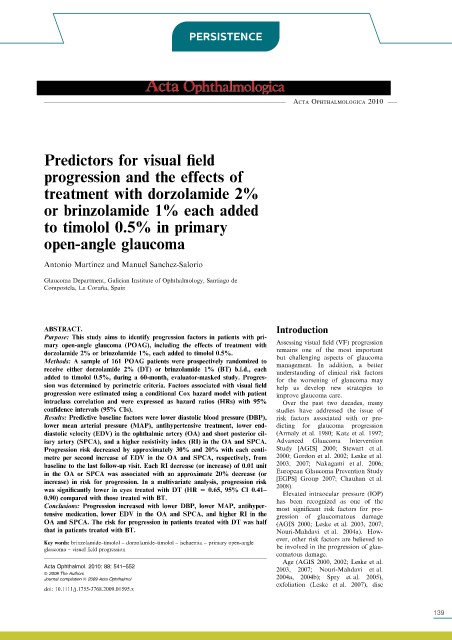Page 139 - DUOKOPT BIBLIOBOOK
P. 139
PERSISTENCE
EFFICACY
Acta Ophthalmologica 2010
Predictors for visual field
progression and the effects of
treatment with dorzolamide 2%
or brinzolamide 1% each added
to timolol 0.5% in primary
open-angle glaucoma
Antonio Martı´nez and Manuel Sanchez-Salorio
Glaucoma Department, Galician Institute of Ophthalmology, Santiago de
Compostela, La Corun ˜ a, Spain
ABSTRACT. Introduction
Purpose: This study aims to identify progression factors in patients with pri-
mary open-angle glaucoma (POAG), including the effects of treatment with Assessing visual field (VF) progression
dorzolamide 2% or brinzolamide 1%, each added to timolol 0.5%. remains one of the most important
Methods: A sample of 161 POAG patients were prospectively randomized to but challenging aspects of glaucoma
management. In addition, a better
receive either dorzolamide 2% (DT) or brinzolamide 1% (BT) b.i.d., each understanding of clinical risk factors
added to timolol 0.5%, during a 60-month, evaluator-masked study. Progres- for the worsening of glaucoma may
sion was determined by perimetric criteria. Factors associated with visual field help us develop new strategies to
progression were estimated using a conditional Cox hazard model with patient improve glaucoma care.
intraclass correlation and were expressed as hazard ratios (HRs) with 95% Over the past two decades, many
confidence intervals (95% CIs). studies have addressed the issue of
Results: Predictive baseline factors were lower diastolic blood pressure (DBP), risk factors associated with or pre-
lower mean arterial pressure (MAP), antihypertensive treatment, lower end- dicting for glaucoma progression
diastolic velocity (EDV) in the ophthalmic artery (OA) and short posterior cil- (Armaly et al. 1980; Katz et al. 1997;
iary artery (SPCA), and a higher resistivity index (RI) in the OA and SPCA. Advanced Glaucoma Intervention
Progression risk decreased by approximately 30% and 20% with each centi- Study [AGIS] 2000; Stewart et al.
metre per second increase of EDV in the OA and SPCA, respectively, from 2000; Gordon et al. 2002; Leske et al.
baseline to the last follow-up visit. Each RI decrease (or increase) of 0.01 unit 2003, 2007; Nakagami et al. 2006;
in the OA or SPCA was associated with an approximate 20% decrease (or European Glaucoma Prevention Study
increase) in risk for progression. In a multivariate analysis, progression risk [EGPS] Group 2007; Chauhan et al.
2008).
was significantly lower in eyes treated with DT (HR = 0.65, 95% CI 0.41– Elevated intraocular pressure (IOP)
0.90) compared with those treated with BT. has been recognized as one of the
Conclusions: Progression increased with lower DBP, lower MAP, antihyper- most significant risk factors for pro-
tensive medication, lower EDV in the OA and SPCA, and higher RI in the gression of glaucomatous damage
OA and SPCA. The risk for progression in patients treated with DT was half (AGIS 2000; Leske et al. 2003, 2007;
that in patients treated with BT. Nouri-Mahdavi et al. 2004a). How-
ever, other risk factors are believed to
Key words: brinzolamide–timolol – dorzolamide–timolol – ischaemia – primary open-angle
glaucoma – visual field progression be involved in the progression of glau-
comatous damage.
Age (AGIS 2000, 2002; Leske et al.
Acta Ophthalmol. 2010: 88: 541–552
2003, 2007; Nouri-Mahdavi et al.
ª 2009 The Authors
Journal compilation ª 2009 Acta Ophthalmol 2004a, 2004b); Spry et al. 2005),
exfoliation (Leske et al. 2007), disc
doi: 10.1111/j.1755-3768.2009.01595.x
541 139

